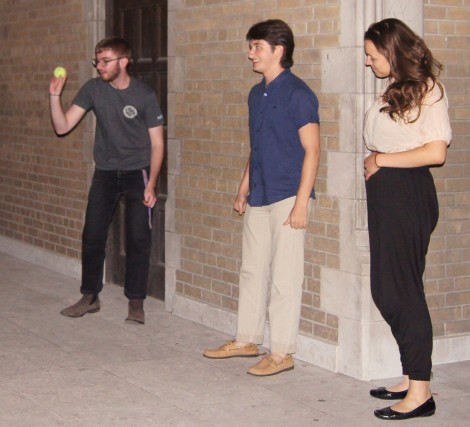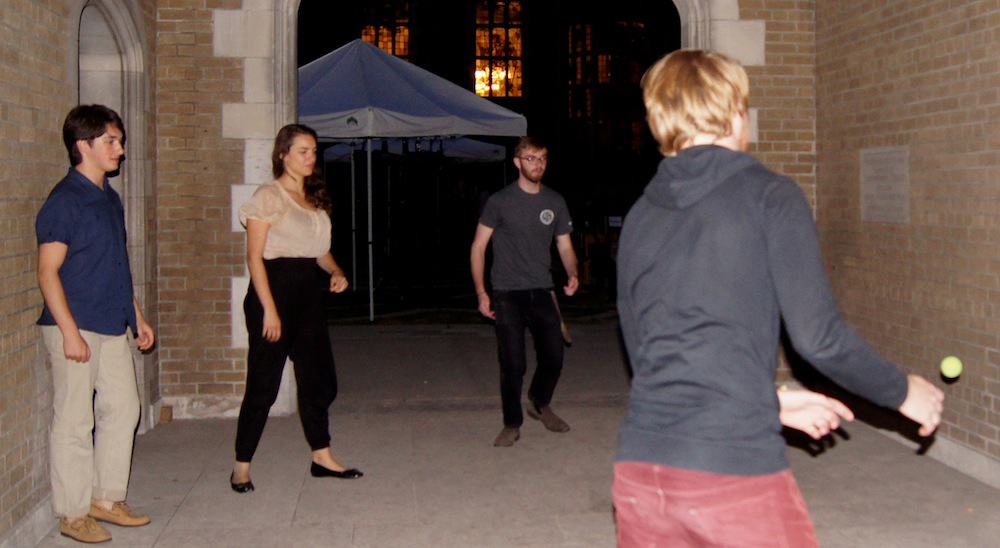I was tasked with the tall order of covering a sport by the name of “wall ball.” Like any good reporter, I pretended to know what wall ball was, and figured I could just Google it later. After Googling, I was even more confused. Apparently there are several different sports by that name. All I could gather about this sport is that it involved a wall, a ball, and Trinity College.
In order to figure this wall ball stuff out, I met with wall ball expert Guy Taylor in the early evening at Trinity College. I was told this would be a true “Trin’ experience” because it would be after the High Table dinner.
When I arrived, eight people were dressed up: men in skinny ties, bowties — everything but a regular tie. They formed a semi-circle inside the Henderson Tower archway before getting started. The archway features two walls, one of which — the one that they choose to play on — has a door in the middle of it.
It was an unseasonably warm night for an October evening; a perfect night for some wall balling. With the season change, the warmth didn’t coincide with extended sunlight. As a result, some of the participants were having trouble seeing the green tennis ball inside the archway.
Regardless, the game went on, obscured by darkness. Some complained about the darkness (“It’s dark in here,” after missing a shot), while others weren’t entertaining any excuses (“I can see when it’s my turn”).

MASHAL KHAN/THE VARSITY
I was starting to understand what wall ball was. I remembered playing a version of this in elementary school, except we called it handball. However, we used many of the same terms (I overheard them using “inners,” an interesting take on the word interference). The name of the sport changes, as do the majority of the rules, but the wall and the ball remain. However, the Trinity College version is unlike any of the others this writer has ever encountered.
Typically, the sport is played against a main wall. The Trinity version employs the use of two walls. The players use a door as a dividing point, encouraging a condensed playing area.
After Taylor finished a spirited game, he decided to come to talk to me about the sport. He was a rather loquacious fellow, ready to tell me everything I needed to know.
“The court is very specific. This is the outer boundary,” he said, pointing to the end of the archway. “Essentially, the game is ‘hit the ball against the wall, and go down the line until you win… last person standing.’”
After mentioning that I played a game like this in grade school, he came back with a quick response.
“When people say you’re just playing an elementary school game, or that it has got grade school origins, our rebuttal is that our rules are long and varied, and very stringently followed. See, right now they are arguing,” he said, pointing to another game that just started, “whether or not it hit the door or the masonry. It’s a big difference: you hit the masonry, it’s a good shot, hit the door, it’s not.”
He went on: “We’ve got some rules designed to keep up the level of play. For example, we won’t allow too many first-years in on a game, in order to maintain a level of play,” Taylor said, as if he were the general manager of a sports franchise attempting to achieve the perfect balance of veterans and rookies on his roster. Like in pro sports, the goal seems to be to produce a productive present and bright future.
Taylor is a veritable encyclopedia of knowledge on wall ball, but I managed to stump him — well, sort of.
“When did wall ball begin?”
“Actually that is one of the greatest questions,” he replied. “No one actually knows.”
“It has existed for at least the past decade. We know that because of people who graduated when I was in first year. And those people said they met people who had been playing it for four years when they came into first year.”
Apparently, everyone knows a guy, who knows a guy, but no one can quite place its origin. Regardless, the game has become a fixture of Trinity College over the last however many years, with no signs of letting up.


